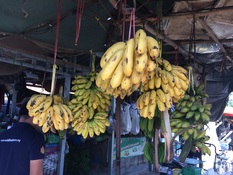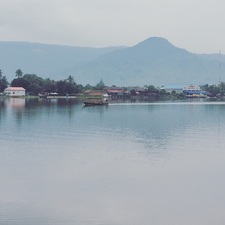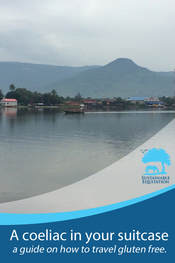
Let’s face it, medical dietary restrictions can be well… restrictive. When you can sometimes struggle to feed yourself in your own city, travelling overseas as a vegan coeliac can seem like mission impossible. But with some planning, research and flexibility it’s not that difficult. And… we found that trying to explain (in another language) your weird dietary requirements to cooks and waiters can actually even add to the trip. So, these are our tips for travelling to SE Asia if you’re a coeliac – they’re not extensive but they might just help make your trip a little less stressful.
Before you go.
The internet is your friend. Google your destination for gluten free restaurants, supermarkets and delis. When we find a good one we screenshot the details so the information is available even when we’re not connected to wifi.
Choose your hotel or guesthouse wisely. We usually try to stay in small hotels or guesthouses that have been well reviewed – Tripadvisor is your friend here but Travelfish and other travel sites are really useful too. We look for guest comments that suggest the owner is flexible and helpful. Big hotels may offer gluten free food as part of the breakfast buffet but a small place is more likely to cook you something to order.
Before you go.
The internet is your friend. Google your destination for gluten free restaurants, supermarkets and delis. When we find a good one we screenshot the details so the information is available even when we’re not connected to wifi.
Choose your hotel or guesthouse wisely. We usually try to stay in small hotels or guesthouses that have been well reviewed – Tripadvisor is your friend here but Travelfish and other travel sites are really useful too. We look for guest comments that suggest the owner is flexible and helpful. Big hotels may offer gluten free food as part of the breakfast buffet but a small place is more likely to cook you something to order.

Once you’ve chosen a place to stay, but before you book, email them and ask them if they can cater for you. If they don’t get back to you promptly or sound uninterested, pick another place. I usually word those emails pretty carefully as I think it really helps to develop a good relationship right from the start. I quite often begin with a brief explanation of coeliac’s disease and finish off with a humorous comment about being normal in every other way. I also always add that we are happy to eat rice and veggies if they can cook that for us with no soy/oyster/fish sauce. When you find a guesthouse that’s keen to help, let them know you’re grateful. If you book months in advance, send them an email the week before you leave and confirm, with a very brief note to remind them of your weird food requirements. It will really help.
The website celiactravel.com (and other websites too) provide restaurant cards in a range of different languages explaining coeliac’s disease. These are fantastic and invaluable. We download the appropriate ones and then make several copies and carry them with us everywhere. We have found that these are really useful – but only if you’re travelling in places where the restaurant staff can read. Also, you need to download all of the languages that you might need. For example, in KL’s Little India we found the Malay card wasn’t particularly useful but the Tamil card was great. If you can’t find the language that you need (Khmer was a bit tricky but we eventually found one) you might be able to ask someone at your guesthouse or hotel to write something down for you.
A note about travelling vegan. We always describe ourselves as vegetarian and work on from there. There is enough confusion about vegetarian and vegan as it is and we’ve found that describing yourself as vegetarian is less likely to cause confusion than any other descriptor. The thing you’re most likely to get served is egg as there’s not a great deal of dairy in most Asian cuisine. It’s usually not hard to add “no egg” to your order.
Once you’re there.
We always take some GF breakfast cereal and muesli bars with us. We never plan on eating them but they might just save you from a hungry night. If you arrive late from the airport and the kitchen has closed or you forget to change money (whoops!) on your way to your hotel or you’re stuck in a small airport with nothing else to eat, you can eat cereal and muesli bars. We always buy fruit at the markets wherever we go and if we’ve got a plane to catch early in the morning or we’re in a bigger hotel and the breakfast has limited options for vegan coeliacs, we’ll eat a big plate of fruit with cereal mixed through.
If you travel by budget airline the choices for vegan GF meals on board are pretty dismal and/or non-existent. We always sneak our own food onto the plane. You’re not supposed to apparently, but no-one has ever taken our food away. We take stuff like fruit, crackers, popcorn, sushi, rice paper rolls, chocolate… anything that’s easy to eat and carry.
If you have connecting flights, it’s worth knowing that most airports are not kind to the dietarily impaired. The budget terminal in KL is bereft of options unless you want to risk the Burger King salads that the website states are GF. If you can find a sushi place that makes to order (there’s a great one in Changi Airport, Terminal One) they can usually make you a GF vegan sushi roll.
It’s a truth universally acknowledged that if a restaurant advertises that it does GF it will also be incredibly difficult to find and/or be open at the strangest times of the day and night. Download the section of Google Maps when you have Wi-Fi, as it will still work off-line. Also, just because a restaurant doesn’t advertise that they can do GF, doesn’t mean they can’t or won’t. In Singapore we had the best meal at a Mexican/Indian fusion (!) restaurant because they understood GF requirements and were happy to help us out. Mexican and South Indian food can often be naturally GF, so we quite often start there in our quest for food. Worst case scenario… you can always eat a bowl of steamed rice with salt and pepper!
Travelling well with food restrictions isn’t hard to do or any more expensive, it just takes a bit of thought and planning. It can even work in your favour… Recently we were able to wriggle politely out of eating some noodles that were made in an outdoor kitchen that shared space with multitudes of chickens, dogs and pigeons. We’re horse trainers and not precious but I’m hesitant to eat at a place where the first step in food preparation starts by pushing several live chickens off the cutting board. Our namby pamby western immune systems are not equipped for such challenges. When offered a big bowl of noodles we were able to sadly shake our heads and show our GF (or Get out of jail Free) card.
We’re always perfecting the GF travel experience and would love to hear from you if you’re experienced at travelling with dietary requirements. Drop us a line and share your story.
The website celiactravel.com (and other websites too) provide restaurant cards in a range of different languages explaining coeliac’s disease. These are fantastic and invaluable. We download the appropriate ones and then make several copies and carry them with us everywhere. We have found that these are really useful – but only if you’re travelling in places where the restaurant staff can read. Also, you need to download all of the languages that you might need. For example, in KL’s Little India we found the Malay card wasn’t particularly useful but the Tamil card was great. If you can’t find the language that you need (Khmer was a bit tricky but we eventually found one) you might be able to ask someone at your guesthouse or hotel to write something down for you.
A note about travelling vegan. We always describe ourselves as vegetarian and work on from there. There is enough confusion about vegetarian and vegan as it is and we’ve found that describing yourself as vegetarian is less likely to cause confusion than any other descriptor. The thing you’re most likely to get served is egg as there’s not a great deal of dairy in most Asian cuisine. It’s usually not hard to add “no egg” to your order.
Once you’re there.
We always take some GF breakfast cereal and muesli bars with us. We never plan on eating them but they might just save you from a hungry night. If you arrive late from the airport and the kitchen has closed or you forget to change money (whoops!) on your way to your hotel or you’re stuck in a small airport with nothing else to eat, you can eat cereal and muesli bars. We always buy fruit at the markets wherever we go and if we’ve got a plane to catch early in the morning or we’re in a bigger hotel and the breakfast has limited options for vegan coeliacs, we’ll eat a big plate of fruit with cereal mixed through.
If you travel by budget airline the choices for vegan GF meals on board are pretty dismal and/or non-existent. We always sneak our own food onto the plane. You’re not supposed to apparently, but no-one has ever taken our food away. We take stuff like fruit, crackers, popcorn, sushi, rice paper rolls, chocolate… anything that’s easy to eat and carry.
If you have connecting flights, it’s worth knowing that most airports are not kind to the dietarily impaired. The budget terminal in KL is bereft of options unless you want to risk the Burger King salads that the website states are GF. If you can find a sushi place that makes to order (there’s a great one in Changi Airport, Terminal One) they can usually make you a GF vegan sushi roll.
It’s a truth universally acknowledged that if a restaurant advertises that it does GF it will also be incredibly difficult to find and/or be open at the strangest times of the day and night. Download the section of Google Maps when you have Wi-Fi, as it will still work off-line. Also, just because a restaurant doesn’t advertise that they can do GF, doesn’t mean they can’t or won’t. In Singapore we had the best meal at a Mexican/Indian fusion (!) restaurant because they understood GF requirements and were happy to help us out. Mexican and South Indian food can often be naturally GF, so we quite often start there in our quest for food. Worst case scenario… you can always eat a bowl of steamed rice with salt and pepper!
Travelling well with food restrictions isn’t hard to do or any more expensive, it just takes a bit of thought and planning. It can even work in your favour… Recently we were able to wriggle politely out of eating some noodles that were made in an outdoor kitchen that shared space with multitudes of chickens, dogs and pigeons. We’re horse trainers and not precious but I’m hesitant to eat at a place where the first step in food preparation starts by pushing several live chickens off the cutting board. Our namby pamby western immune systems are not equipped for such challenges. When offered a big bowl of noodles we were able to sadly shake our heads and show our GF (or Get out of jail Free) card.
We’re always perfecting the GF travel experience and would love to hear from you if you’re experienced at travelling with dietary requirements. Drop us a line and share your story.


 RSS Feed
RSS Feed
